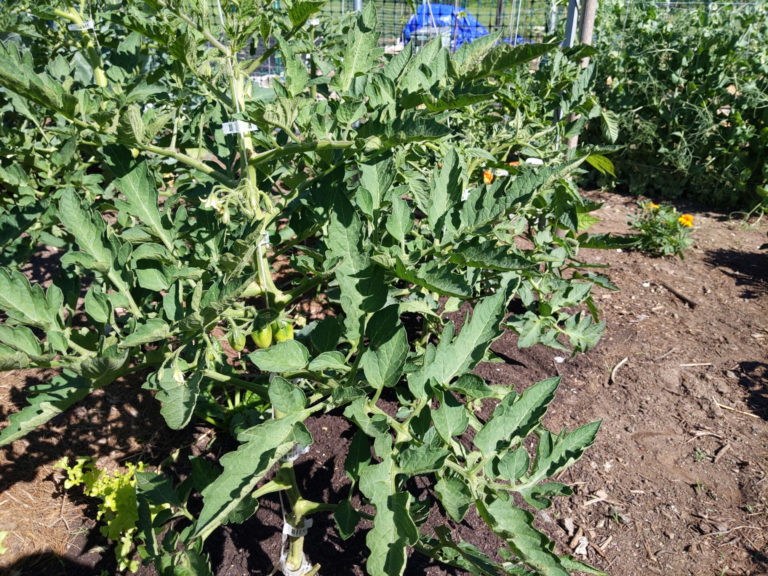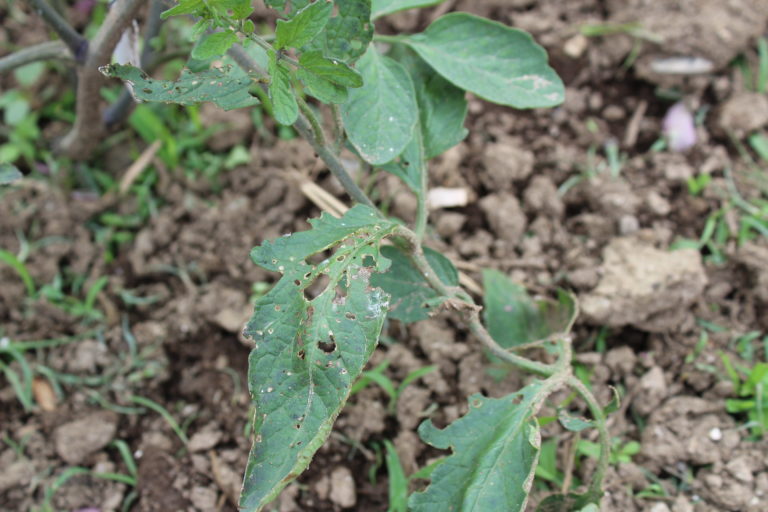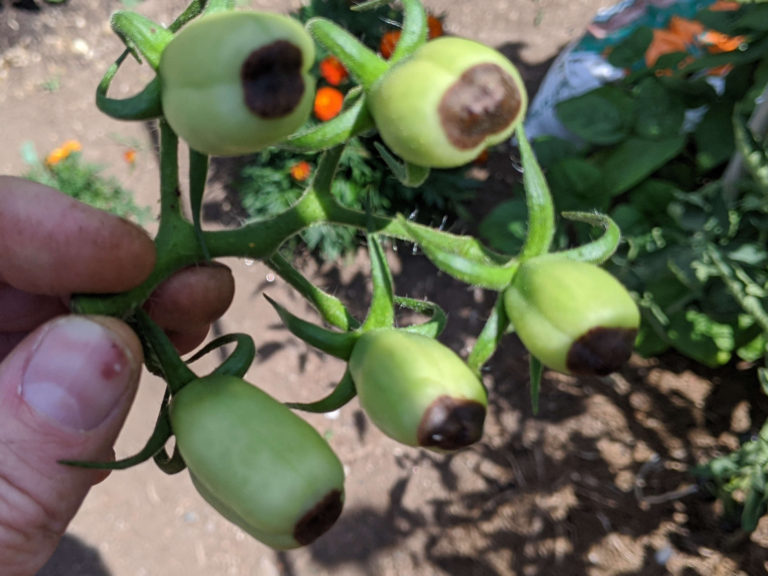Tomatoes
Selection and Planting
Tomato Varieties
All tomatoes are grouped into two categories: determinate and indeterminate.
Determinate
Commonly referred to as bush tomatoes, these are plants that have been bred to remain relatively small to the point where trellising and pruning is, for the most part, unnecessary. They tend to have fruit that ripen within a few weeks which can be very beneficial for those who want to preserve their harvest.
Indeterminate
Most of the tomato varieties you have seen are indeterminate. This means they grow as vines that can reach 10 feet long or even more. Trellising is required to keep the plants off the ground. As the vines grow, clusters of fruit form which gives gardeners a steady supply of tomatoes throughout the season. This type of plant is useful for those who want to eat fresh tomatoes.
Planting
Tomatoes in Rose Tree Garden should always be grown from healthy transplants purchased from reputable garden centers or grown under lights from seed. If you are new to gardening, no not try growing plants from seed. Never try starting tomato plants from seeds in the garden.
Plants shouldn’t be transplanted into your garden before the 1st of May. Wait until the nightly temperature forecast for the next week remains above 50 degrees. Planting tomatoes too early may result in stunted growth and reduced harvests.
Plant spacing depends on the method of trellising used. Generally, tomato plants should not be planted closer than 24″ apart. Proper spacing will allow for adequate airflow around the plants which will reduce the likelihood of pest and disease issues later in the season. When growing tomatoes for the first time, start with a wider spacing (~36″) so you can become accustomed to how large the plants can get later in the season.
Before transplanting, remove the leaves on the bottom half of the plant. dig a hole deep enough so that the bottom 1/3 of the stem is below ground. Because tomatoes grow new roots out of any part of the stem that is buried, this will result in stronger plants later in the season. Water the plant well.
Growing Tomatoes
Pests
Tomatoes are susceptible to a number of pests. Regularly check the plants for signs of insect damage. Be aware of the pests that frequent tomatoes and use the links below to determine the best ways to control them. Examples of insect damage are shown below.
Large numbers of aphids cause leaves to curl as a stress response. If your plant is showing leaf curl, closely inspect the plants for aphids.
Beetle larvae consume tomato leaves leaving numerous irregularly-shaped holes. Beetles consume leaves around the edges.
Diseases
Tomato plants are susceptible to a variety of diseases, some of which will result in the death of the plant. Care must be taken to prevent diseases before they are able to take hold. Below is a list of three steps you can take to improve your chance of growing healthy tomato plants
- Plant spacing: Tomato plants that are positioned too close together will result in higher levels of humidity near the leaves due to air not being able to move between the plants. Making sure to give plants plenty of space will improve airflow and reduce the likelihood of disease
- Watering: Never water your tomato plants by spraying the leaves. Always water carefully at the base of the plant in order to limit the chance of dirt splashing up on the leaves. This splashing is the main way diseases enter tomato plants.
- Crop rotation: A number of plant diseases come from a slow buildup in the soil over a period of time. Crop rotation (not growing plants in the same place every year) will keep the amount of soil disease low. Every year, move your plants to a different part of your garden that hasn’t hosted tomatoes for the past 3 years.
Verticillium/Fusarium wilt is by far the most common disease seen by gardeners. Plant problems result from a slow buildup of the disease in the soil over a number of years. Rotating your crops every year is very important to reducing the amount of disease in the soil. The higher the buildup, the more damage the plant receives. This damage manifests itself browning and dying leaves that start at the bottom of the plant and work their way up the plant as the season progresses.
If your plants suffer from Verticillium/Fusarium wilt, look for resistant varieties indicated by V and F on the plant label. Grafted tomato plants will provide more protection against the wilts, but the plants tend to be more expensive.
Blossom end rot can be identified by dark/rotting spots on the flowering end of the fruit.
Beginning in the middle of the season, leaves at the bottom of the plant will turn brown. The browning will work its way up the plant as the season progresses.
Growth cracks on tomatoes often originate at the stem and continue down the fruit. They may also be seen spiraling around the fruit.
Watering
Maintaining consistent soil moisture levels will improve plant growth and reduce the likelihood of fruit developing blossom end rot. Monitor both the soil moisture and rainfall using the Rose Tree Garden Weather Data and water your plants when soil moisture decreases or the garden has not received at least 1″ of rainfall in the past week.
When watering, be sure to avoid overhead sprinkling as this increases the likelihood of soil-borne diseases spreading to the plant. Water slowly at the base of the plant over a period of an hour to encourage deep root growth. Long and infrequent watering encourages the plant to focus on root development which will enable it to survive through periods of drought.
Weed Control
Keep area under tomato plants clear of weeds to prevent competition. Use a garden hoe or hand pulling to remove the weeds. Reduce the weed pressure by following our Weed Prevention suggestions.
Harvesting
Tomatoes should be harvested when fruit has reached the desired color. Waiting too long increases the likelihood of the fruit splitting on the vine, so it is better to harvest earlier and letting the fruit finish ripening off the vine.
Fruit splitting occurs when the flesh inside the tomato expands faster than the skin. This is more likely when the fruit approaches peak ripeness and/or after rainfall when the abundance of water will rush into the fruit and quickly expand the flesh. Monitor rain forecasts as your fruit approaches peak ripeness and harvest early if rain is forecast.





